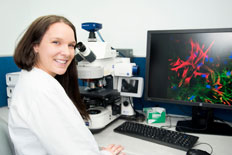

Gabriella Lindberg
“Most people think cartilage is a pretty simple structure, but it's not. It's complex. Strong, very viscoelastic and with layers of unique patterns of cells and proteins but without any vasculatures. So it doesn't regenerate well on its own. This makes it quite a hard tissue to replicate, and no one has done that yet with good enough quality and functionality.”
Christchurch Regenerative Medicine and Tissue Engineering (CREaTE) group PhD student, Gabriella Lindberg, is part of a team working on the difficult task of printing large, viable pieces of cartilage to ultimately be used as replacement tissue in human surgery.
3D Bioprinting, where biological materials such as cells are printed into 3-dimensional human parts, is one day expected to revolutionise healthcare. But there are still many basic hurdles to overcome. A key one is that the materials that cells like are soft and too liquid to print with. The trick is then to design a range of materials, known as bioinks, that offers both a good cell environment and that can be printed with good resolution into any larger structures at room or body temperature.
Gabriella's role in the CREaTE team is to design the ideal material for cartilage or stem cells to grow in, so they are in optimal condition when printed but also providing a long-term function. During her PhD she is experimenting with different variations of polymers and biological factors to fabricate smarter bioinks.
“Cells are very responsive to the environment they are in. My aim is to take cartilage or stem cells and find the best 3D-environment for them to grow and feed in, which constantly changes over time as the tissue is forming' she explains.
“I want to let the cells be the engineers and give them a material platform that has the capacity to adapt to and upregulate the right biochemical cues over time to best guide their development.”
Gabriella is being supervised during her PhD by orthopaedic surgeon Gary Hooper and CREaTE group members Associate Professor Tim Woodfield and Dr Khoon Lim.
A native of Sweden, Gabriella chose to do postgraduate study at the University of Otago, Christchurch, because of its international reputation for research into regenerative medicine.
She also wanted to live in a city that offered easy access to the great outdoors.
“Since I was a little girl I was attracted to New Zealand's beautiful scenery and I have enjoyed living in Christchurch where it is easy to get out and do lots of physical activities. I love soccer and skiing but basically I enjoy all sports and being active.”